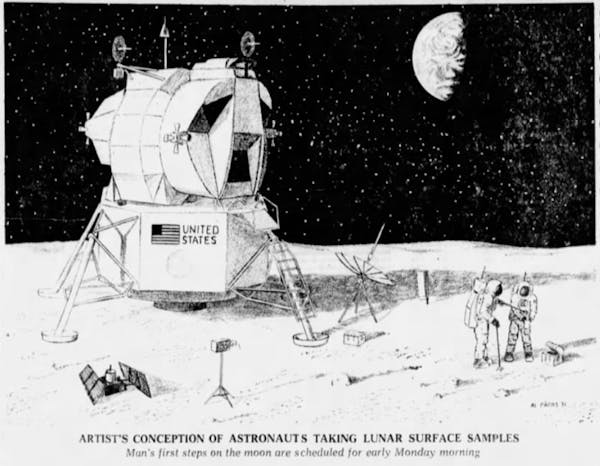To honor the 50th anniversary of the Apollo 11 moon landing, Medina-based Polaris Industries built a replica of the lunar rover using spare parts from its vast motorcycle, snowmobile and all-terrain vehicle product line.
Members from NASA's original lunar rover vehicle crew and a NASA astronaut worked with Polaris for nine months to make the lunar rover replica a reality.
The team from the U.S. Space and Rocket Center first approached Polaris about the project in May 2018. They then worked with Polaris engineers from Huntsville, Ala., plus Wyoming and Roseau in Minnesota, to tackle gravity, weight and other issues associated with the machine's purpose on the moon.
"As the No. 1 in off-road vehicles, this was the ultimate off-road project for Polaris. We used parts from across our product lineup to create the replica," said Bryan Ogle, Polaris' manufacturing manager.
The machine is appearing in 50th-anniversary celebrations across Huntsville, where Polaris has a large manufacturing facility and NASA has a flight center.
"Having the opportunity to honor legends, work with members of the original crew and lend our expertise and technologies to build this lunar rover replica has been incredible," Ogle said. "One of the coolest things was being able to mold the fiberglass fenders using the original 50-year-old molds. And now seeing it in action, riding it — it's amazing."
The new Polaris lunar rover replica made its debut July 13 at the U.S. Space and Rocket Center's Apollo Celebration show in Huntsville and will make appearances at NASA's Marshall Space Flight Center and other anniversary events in Alabama and Florida.
The new rover weighs about 1,500 pounds and drives fine, braking, accelerating and using four-wheel "Ackermann" steering just like the original rover, officials said.
Engineers noted a key difference in today's replica — it can go faster than the original lunar vehicle, which still sits on the moon.
The original drove 8 mph. The new one was designed to travel 12 mph, but can be adjusted to reach 60 mph during testing, said Polaris spokeswoman Jess Rogers.
The lunar replica is a Frankenstein's monster-like beast, made of parts snatched from each division of Polaris' extensive product portfolio.
The battery came from Polaris' tiny electric vehicles. The steering rack came from Polaris' three-wheel Slingshot roadster. And its exhaust valve actuator came from a Polaris snowmobile. The lunar rover's arms, shafts and power steering, and chassis came from an array of all-terrain vehicles and side-by-sides. The joystick mimicked the original, and was made by 3-D printers duplicating the exact measurements from the first rover.
Polaris, which generated about $6.1 billion in 2018 revenue, will release second-quarter earnings on Tuesday.
Dee DePass • 612-673-7725
Biden administration moves to make conservation an equal to industry on US lands

